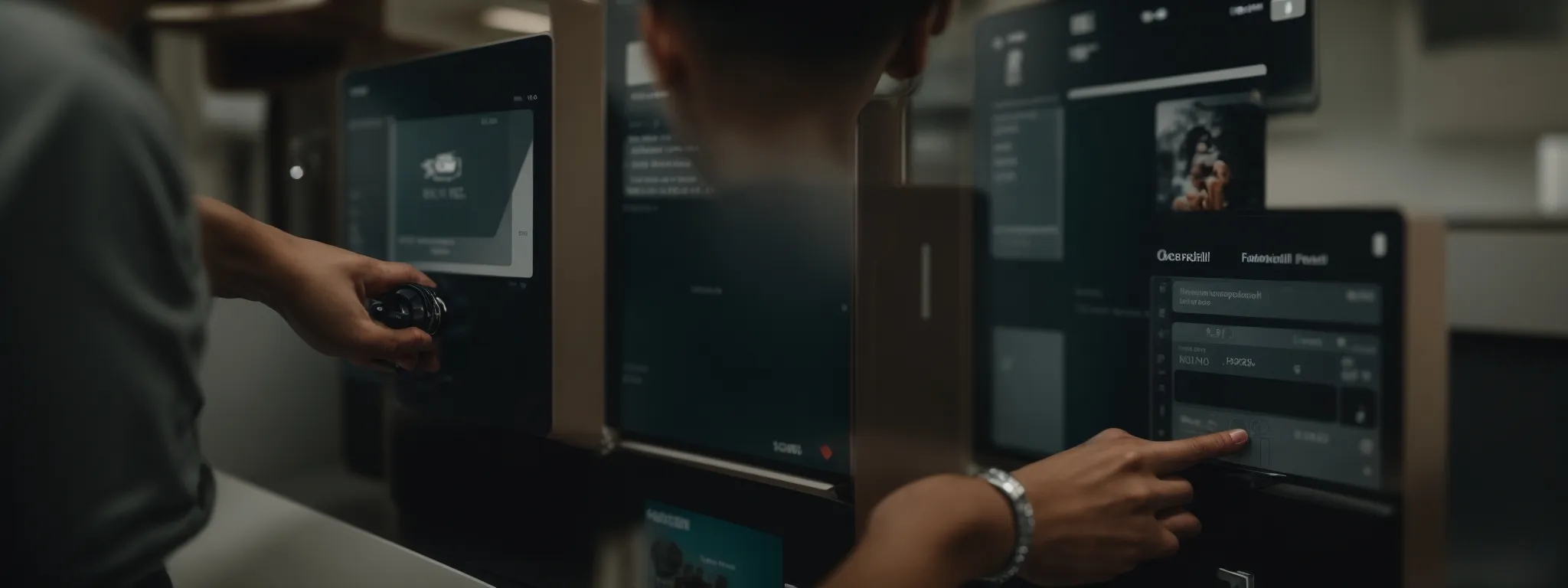Driving Revenue: The Power of Conversion Rate Optimization
Maximizing Profits: Unlocking the Potential of Conversion Rate Optimization In the dynamic landscape of digital marketing, conversion rate optimization (CRO) stands as a critical component for businesses […]
Maximizing Profits: Unlocking the Potential of Conversion Rate Optimization
In the dynamic landscape of digital marketing, conversion rate optimization (CRO) stands as a critical component for businesses aiming to maximize their online potential.
By strategically enhancing web pages and marketing channels, companies can craft a more compelling user experience, leading to improved conversion rates and significant revenue growth.
This intricate process not merely adjusts the superficial elements but delves into the profound understanding of visitor behavior and tailors an interactive journey that resonates with the target audience.
Keep reading to discover how expertly employed CRO tactics can transform website traffic into loyal customers and amplify your bottom line.
Key Takeaways
- Conversion Rate Optimization Is Essential for Maximizing Revenue Without Increasing Traffic or Ad Spend
- A Data-Driven Approach and Continuous Testing Are Crucial for Long-Term Success in CRO
- Personalization and Understanding User Behavior Increase Engagement and Conversion Rates
- Mobile Optimization and Quick Page Loading Are Key to Converting on-the-Go Users
- Utilizing CRO Tools Like Heatmaps and a/B Testing Platforms Can Significantly Improve Online Profitability
Understanding the Basics of Conversion Rate Optimization

In the realm of e-commerce, the efficiency with which a website converts visitors into customers determines the trajectory of revenue growth.
This is where Conversion Rate Optimization (CRO) emerges as a cornerstone component.
At its core, CRO entails a meticulous process, one that scrutinizes user behavior to provide a seamless navigational experience, thereby enhancing the probability of transforming site visitors into loyal customers.
Its significance cannot be overstated, as CRO not only bolsters the effectiveness of marketing channels but also ensures that marketing efforts resonate at each stage of the consumer’s journey.
Hence, mastering CRO is tantamount to Unlocking the Full Potential of a brand’s marketing strategy, fostering a robust bottom line by optimizing every touchpoint within the marketing funnel.
Defining Conversion Rate Optimization (CRO)
Conversion Rate Optimization, abbreviated as CRO, is a systematic approach focused on increasing the percentage of website visitors who take a desired action, be that completing a purchase, signing up for a newsletter, or filling out a contact form. It involves understanding what drives, stops, and persuades users, then applying that insight to improve the user experience and drive conversions.
At its essence, CRO is the art of fine-tuning a website to foster a more compelling user journey that aligns with business objectives. It spans a range of activities, from modifying the layout of a landing page to overhauling the copy on a product page, all in pursuit of nudging the visitor towards becoming a customer.
The Importance of CRO in E-Commerce Success
The imperative for Conversion Rate Optimization in an e-commerce setting is a direct response to the need for businesses to maximize return on investment. Effectively implementing CRO strategies leads to a more efficient conversion of site visitors to purchasing customers, thereby driving revenue without necessarily increasing website traffic or advertising spend.
Understanding the CRO process and its impact can be likened to a captain navigating a ship through tumultuous waters; every tweak and adjustment in the journey enhances overall performance and steers towards the ultimate destination of business success:
- Evaluating each element of the user experience for potential friction points that may inhibit conversions, such as a complex checkout process or unclear value proposition.
- Employing data-driven methodologies to test different variables, like website copy, CTAs, and page layouts, ensuring that each decision is informed by user behavior and preferences.
- Initiating continual improvements informed by conversion rate data, personalization tactics, and user feedback to create an ever-evolving, optimized e-commerce platform.
As companies navigate through the competitive landscape of digital commerce, those that prioritize CRO are better positioned to capitalize on their existing web traffic. This strategic focus not only streamlines the path to purchase but also amplifies the effectiveness of all marketing channels, culminating in sustainable competitive advantage and enhanced customer satisfaction.
How CRO Fits Into the Marketing Funnel
Within the intricate architecture of the marketing funnel, Conversion Rate Optimization plays a strategic role at each layer, honing in from awareness to action. Embracing CRO equips businesses with the precision to carve out more effective customer acquisition strategies, drive engagement, and finesse the transition from interest to decision-making, fueling the pivotal moments that lead to a transaction.
CRO interweaves with the marketing funnel by refining the messaging and user experience at stages where potential customers consider the value proposition, compare offerings with competitors, and finally make the leap to conversion. This synergy enhances the cohesiveness of marketing efforts, ensuring that every visitor encounters an optimized path to becoming a loyal patron of the company’s product or service.
Driving Revenue With Effective CRO Strategies

In the digital marketing arena, savvy businesses acknowledge that their website is a dynamic entity ripe with untapped potential.
A rigorous approach to Conversion Rate Optimization (CRO) can unveil a myriad of opportunities to elevate conversion rates, thereby contributing substantively to revenue.
Identifying these opportunities on one’s website involves a deep dive into user behavior, seeking to understand and remove barriers to conversion.
By meticulously tailoring the user experience to better meet the expectations of site visitors, companies can foster an environment conducive to conversion.
Moreover, leveraging A/B testing serves as the keystone in this optimization process—providing critical insights that guide strategic, data-driven adjustments for improved results.
As businesses commence this journey, they inch closer to realizing the profound impact of CRO strategies, capitalizing on the latent potential within their digital presence to maximize profits.
Identifying Conversion Opportunities on Your Website
Delving into the multitude of nuances that make up a website’s interface, one finds that systematically identifying areas for optimization can significantly enhance profit margins. Companies that employ expert analytics to pinpoint where users disengage or hesitate within the site empower themselves to craft solutions that directly address these pain points, thus boosting the likelihood of conversion.
For a website fraught with underperforming web pages, conversion opportunities may lie hidden within elements as straightforward as headlines or CTAs. A professional assessment that focuses on iteratively testing and refining these elements can lead to incremental improvements in user experience, ultimately fostering a higher rate of visitor-to-customer transformation.
Tailoring User Experience to Encourage Conversions
The endeavor to mold the user experience into a conversion-friendly journey hinges on astute observation and actionable insights. By customizing webpage elements to resonate with the target audience’s preferences and expectations, businesses ensure website visitors encounter minimal friction on their path to conversion.
Pivotal to encouraging conversions is the harmonization of a webpage’s aesthetic and functional features with the user’s intentions. This alignment creates an intuitive flow that subtly guides site visitors from initial interest through to a fulfilling engagement with the company’s digital assets.
Leveraging a/B Testing for Optimized Results
In the rigorous sphere of Conversion Rate Optimization, a/B testing stands as a critical method for decision-making and strategy refinement. By creating and comparing different versions of a web page or a single website element, companies can empirically determine which variation resonates more effectively with their audience, leading to optimized conversion rates.
Businesses that engage in a/B testing can exploit a direct line into the psyche of their site visitors, gaining invaluable insights that inform more Impactful Changes. This embracement of empirical evidence over conjecture ensures that each tweak is propitious, heightening the efficacy of the conversion journey and contributing meaningfully to overall revenue enhancement.
Analyzing User Behavior to Improve Conversion Rates

In the pursuit of amplified profits through digital marketing solutions, discerning the intricacies of user behavior stands paramount for Conversion Rate Optimization (CRO).
Deliberate analysis and interpretation of how visitors interact with a website reveal patterns and preferences, offering a blueprint for strategic enhancements.
Organizations that capitalize on tools like heat maps, robust analytics, and constructive customer feedback, position themselves to refine their marketing efforts, hone their value propositions, and thus, foster a marked improvement in conversion rates.
Grasping the significance of these tools sets the stage for a comprehensive understanding of user engagement, illuminating the path to optimized user experiences and increased profitability.
Utilizing Heat Maps for Better Understanding User Interaction
Heat maps serve as a window into the user’s journey, capturing the most engaged portions of a website with striking visual representations. These vibrant overlays provide at-a-glance insights into where users click, scroll, and linger, delineating hotspots that command attention and areas that may necessitate refinement for facilitating smoother interactions and guiding visitors towards conversion goals.
Adopting heat maps as part of a digital marketing strategy allows businesses to empirically identify website elements that resonate with or repel users. This understanding is pivotal in re-engineering web pages for optimized user experience, ensuring that navigational pathways, content placement, and call-to-actions are strategically positioned to bolster user engagement and amplify conversion rates.
The Role of Analytics in Shaping CRO Initiatives
The pervasive influence of analytics is transforming the landscape of Conversion Rate Optimization, propelling data to the forefront of strategic decision-making. By dissecting visitor interactions, analytics inform every nuance of the marketing strategy, shedding light on performance metrics and user preferences that underpin successful CRO.
Analytics foster a culture of continuous improvement, equipping businesses with the tools required to monitor and adapt to changing user behavior. Armed with analytical insights, companies can align their CRO initiatives with empirical data, ensuring their conversion tactics are both relevant and effective:
| Aspect of CRO | Impact of Analytics | Strategic Actions |
|---|---|---|
| User Experience | Provides data on navigation patterns and user engagement | Optimize web page layout and content placement |
| Conversion Pathways | Highlights the most and least efficient paths to conversion | Refine funnel steps and simplify the conversion process |
| Page Performance | Identifies high and low performing pages | Enhance copy, imagery, and CTAs of underperforming pages |
Harnessing Customer Feedback for Actionable Insights
Customer feedback emerges as a critical compass in the pursuit of enhancing Conversion Rate Optimization. By assimilating direct input from customers, companies can pierce through the veil of assumption and harvest concrete, user-generated insights, thereby fine-tuning the facets of their digital offerings that matter most to their clientele.
Actively integrating customer perspectives into CRO strategies not only signals responsiveness but refines the narrative of the brand. This continuous stream of feedback propels iterative improvements, forging a path to an elevated user experience and a substantial increase in conversion efficacy.
Enhancing User Engagement Through Page Optimization

As digital marketing strategists seek to amplify profitability, they recognize the undeniable influence of Conversion Rate Optimization (CRO) in transforming websites into powerful revenue-generating engines.
A high-converting landing page remains a linchpin in this equation, with its capacity to captivate and compel being instrumental in guiding potential customers through the final steps of the conversion process.
Persuasive copywriting plays a pivotal role in this scenario, as it stands as the voice that communicates a brand’s value proposition and calls to action, melding persuasive elements with a keen understanding of target audience psychographics to stimulate engagement and drive commercial success.
Key Components of a High-Converting Landing Page
A high-converting landing page seamlessly marries clarity with allure, ensuring that each visitor is immediately aware of the unique value proposition and is encouraged to act on it. This critical web page must feature a compelling headline that captures attention and succinctly communicates the core benefit or solution provided by the product or service.
Every landing page should facilitate a frictionless user experience, with strategic layouts that guide visitors towards conversion through intuitive design and persuasive call-to-action (CTA) buttons. Striking a balance between aesthetic appeal and functional simplicity, the page’s architecture must intuitively channel the user’s journey towards the fulfillment of the conversion goal.
The Role of Persuasive Copywriting
The persuasive prowess of copywriting serves as the fulcrum for tipping the scales in favor of conversion. Engaging, action-driven copy does not merely inform but entices, transforming passive browsers into active participants in the company narrative.
Effectively executed copywriting maps out a clear journey: it spotlights the pain points of the audience, then positions the product or service as the remedy, thereby weaving a compelling case for immediate action. The following elements outline the essentials of copy that converts:
- Clearly articulated benefits that resonate with the target audience, illustrating how the product or service solves specific problems.
- Strategically placed calls-to-action that serve as beacons, guiding users toward the next step in their consumer journey.
- Emotionally charged language that connects on a human level, fostering trust and establishing the brand as a relatable ally.
Simplifying the Checkout Process for Higher Conversions

In a fiercely competitive digital marketplace, the pursuit to maximize profits continues to drive advancements in user experience.
Paramount to this endeavor is the checkout process—a critical juncture where the ease of transaction profoundly impacts a customer’s propensity to complete a purchase.
It is here that businesses must employ deliberate tactics to streamline navigation, thereby encouraging swift and effortless purchases.
Additionally, reducing cart abandonment through checkout optimization has become central to enhancing conversion rates, ensuring that shoppers who have signaled purchase intent are not lost to complexities or inefficiencies at this final, crucial stage.
Streamlining Navigation for Quick and Easy Purchases
Streamlining the navigation to provide quick and easy purchases stands as an essential strategy in elevating conversion rates. By removing unnecessary steps, clarifying the path to purchase, and ensuring a fluid progression from product selection to final transaction, businesses eliminate barriers to conversion, effectively reducing the chance of cart abandonment.
Employing intuitive design elements that anticipate the needs of site visitors works to guide them effortlessly through the checkout process. This optimization of the purchasing pathway not only decreases the exit rate but also reinforces the user’s confidence in the transaction, contributing to a robust conversion rate that impacts the bottom line favorably.
Reducing Cart Abandonment With Checkout Optimization
Addressing cart abandonment remains a critical challenge in optimizing the checkout experience and, subsequently, bolstering conversion rates. By refining the checkout process to be as swift and straightforward as possible, businesses present shoppers with a clear, unobstructed path to purchase, thus minimizing the risk of losing customers at this decisive phase.
Optimization efforts, such as offering guest checkout options, transparent pricing, and multiple payment methods, contribute substantially to the reduction of cart abandonment. These strategic adjustments to the checkout experience reinforce a consumer’s commitment to completing a transaction, transforming mere interest into tangible sales.
Personalization Tactics to Boost Conversion Rates

In today’s digital marketplace, personalization not only distinguishes a brand but significantly amplifies its conversion rates.
By tailoring the online experience to individual user preferences, businesses enhance engagement, deepen customer loyalty, and drive profit margins.
Personalization tactics, such as targeted offers and user segmentation, allow companies to deliver curated content and recommendations that resonate closely with their audience.
These strategies not only cater to the specific needs of each visitor but also transform a general marketing approach into a personalized dialogue, vastly increasing the likelihood of conversion.
Implementing Targeted Offers and Recommendations
Embracing the power of personalization, businesses are now incorporating targeted offers and recommendations into their user experience, Leveraging Sophisticated Algorithms and user data to present options that appeal to the individual consumer’s history and preferences. By displaying tailored content, companies engender a sense of exclusivity and relevance, elevating the user’s engagement and paving the way for increased conversions.
The strategic implementation of personalization can be witnessed through the careful parsing of user data to understand and predict what offers will resonate the most. Targeted recommendations act as a catalyst for user action, driving not only the conversion rate but also the average order value, as shoppers are more likely to purchase products that meet their specific wants and needs:
| Personalization Element | Impact on User Behavior | Resultant Benefit |
|---|---|---|
| Targeted Offers | Increases perceived value for users | Heightened user engagement |
| Recommendations | Facilitates discovery of relevant products | Amplified conversion rate and AOV |
Crafting Personalized Experiences With User Segmentation
Segmentation stands as a critical undertaking in the personalization landscape, enabling businesses to categorize their users into distinct groups based on behavior, demographics, and purchase history. By employing user segmentation, a company can design experiences that are tailored to the specific characteristics and preferences of each group, thereby enhancing the relevance of their digital marketing efforts and boosting conversion rates.
This methodical segmentation facilitates the crafting of nuanced customer experiences that resonate on a personal level, driving deeper connections with the brand. Companies utilizing segmentation can create a more focused, individualized narrative for each customer, which not only accelerates the conversion process but also fortifies customer loyalty and lifetime value.
Mobile Optimization: Catering to the on-the-Go Consumer

As the proliferation of mobile devices continues to reshape consumer behavior, the imperative for businesses to optimize their digital frameworks for mobile users grows increasingly critical.
The advent of smartphones and tablets has ushered in an era where customers expect rapid access and seamless interactions, irrespective of their location or device.
In this digital milieu, the conversion rate optimization (CRO) landscape must adapt to the priorities of mobile optimization to maintain a competitive edge.
A mobile-friendly design and speed optimization are not just enhancements but essentials that directly impact a site’s ability to convert the casual mobile browser into a confirmed customer.
This necessitates a strategic approach to mobile CRO, focusing on the minutiae of user experience tailored to the constraints and conveniences of mobile technology.
Importance of Mobile-Friendly Design in CRO
In an era dominated by mobile usage, aligning the principles of Conversion Rate Optimization with mobile-friendly design is no longer optional for businesses; it is a necessity. A mobile-optimized interface caters to the growing demographic of users who rely on their smartphones and tablets for shopping, information, and services, ensuring that obstacles to conversion are minimized for these on-the-go consumers.
By focusing on mobile design within their CRO strategies, businesses unlock a plethora of opportunities, which can significantly enhance the user experience and conversion potential on smaller screens:
- Streamlined navigation tailored for touch interactions
- Responsive web page layouts that adapt seamlessly across devices
- Quick-load pages to reduce bounce rate and encourage user retention
Ensuring a mobile-optimized presence ultimately augments conversion rates by providing a frictionless and intuitive user experience, regardless of the device. This capability stands as a pivotal component in maintaining a competitive edge in the digital landscape, empowering businesses to meet and exceed the expectations of their increasingly mobile audience.
Speed Optimization Techniques for Mobile Users
Achieving Swift Page Loading on mobile devices is an integral aspect of conversion rate optimization, with speed firmly established as a key influencer in the retention of mobile users. By deploying compression techniques and minimizing code, businesses can significantly accelerate page load times, fostering a rapid and responsive environment that supports the conversion process.
Optimizing images for mobile platforms is another crucial strategy; ensuring graphics are appropriately scaled and compressed for small screens without compromising quality. This meticulous attention to detail in image handling can prevent sluggish load times, which are often the tipping point between a user’s engagement and their exit from the site.
Harnessing Social Proof to Validate Purchase Decisions

In today’s digital marketing landscape, the judicious application of social proof has proven indispensable in validating consumer purchase decisions and catalyzing conversion rate optimization.
As businesses strive to maximize profits and engender trust within their target audience, leveraging the persuasive power of social proof becomes a strategic imperative.
This encompasses a tactical employment of customer reviews and testimonials as well as the integration of trust badges and guarantees, all tailored to build credibility and relinquish any lingering consumer hesitations, forging a pathway to accelerated conversion and revenue growth.
Incorporating Customer Reviews and Testimonials
In the pursuit of amplifying conversion rates, the strategic integration of customer reviews and testimonials into a business’s online presence serves as a solid trust foundation. These authentic endorsements act as powerful trust signals, assuring potential customers of the quality and reliability of a company’s offerings.
| Element of Social Proof | Function in CRO | Resultant Impact on Conversion |
|---|---|---|
| Customer Reviews | Boosts credibility through shared customer experiences | Increases consumer confidence, driving higher conversion rates |
| Testimonials | Highlights successful use cases and product satisfaction | Enhances trust and encourages visitors to convert into customers |
Presenting these customer stories prominently on key conversion pages, such as product or pricing pages, can significantly influence the decision-making process: shoppers resonate with the experiences of peers, making them more inclined to complete a purchase with confidence.
Utilizing Trust Badges and Guarantees to Enhance Credibility
Utilizing trust badges and guarantees strategically on a website can significantly elevate user trust and lend credibility to an online business. These symbols of assurance not only instill confidence in potential customers but also serve as pivotal trust signals, directly contributing to the fortification of the site’s reputation and the boosting of conversion rates.
Trust badges, sourced from reputable third-party entities, confirm a site’s security and legitimacy, while guarantees such as money-back pledges articulate a company’s commitment to customer satisfaction. Together, these elements constitute a silent yet authoritative endorsement of the brand, assuring users that their interests are protected and their transactions are secure:
- Display of security trust badges reassures users of data protection.
- Service and product guarantees highlight a brand’s reliability and service quality.
- Endorsements from recognized entities lend weight to a company’s standing in the industry.
Best Practices for Long-Term CRO Success

In the relentless quest to enhance profitability through digital marketing strategies, the emphasis on Conversion Rate Optimization (CRO) has never been more pronounced.
The path to sustaining a successful CRO program lies in adopting a steadfastly data-driven approach and nurturing an environment where continuous testing becomes the bedrock of decision-making.
Together, these underpinning practices herald a paradigm where every conversion opportunity is captured and leveraged, reinforcing a foundation for enduring growth and competitive agility in the fast-paced digital marketplace.
Adopting a Data-Driven Approach in CRO
In the grand puzzle of Conversion Rate Optimization, the adoption of a data-driven approach is akin to an expertly calibrated compass: it guides strategy with precision and reliability. By anchoring CRO tactics in empirical data, businesses ensure that their efforts to enhance the user experience and conversion rates are grounded in user behavior insights and factual analytics.
This methodical approach transforms raw data into actionable intelligence, creating an iterative CRO process that aligns with evolving consumer trends and preferences. Solidifying the link between marketing strategies and measurable outcomes, a data-driven approach underpins every successful conversion-centric initiative:
| CRO Element | Key Data Metrics | Impact on Strategy |
|---|---|---|
| User Engagement | Click-through rates, time on page, interaction rates | Refines content and layout to foster deeper user involvement |
| Conversion Funnel Analysis | Drop-off points, conversion path efficiency | Optimizes the steps in the buying process to reduce friction and abandonment |
| Page Performance | Bounce rates, conversion rates, user feedback | Tailors individual web pages to better meet and engage the target audience |
Employing a data-driven framework steers companies away from conjecture-based decisions, leading instead towards precise, informed actions that are demonstrably effective in elevating conversion rates. This fidelity to data empowers businesses to continuously refine and adapt their CRO strategies, setting the stage for long-term success and revenue maximization.
Fostering an Organizational Culture of Continuous Testing
Cultivating an environment that cherishes continuous testing is crucial for organizations aiming to refine and enhance their conversion rate optimization strategies persistently. This commitment to perpetual experimentation reinforces a proactive posture within the company, encouraging teams to embrace adaptability and innovation as cornerstones of their growth-oriented mindset.
By ingraining continuous testing into the company ethos, businesses create a dynamic feedback loop where every test, whether successful or not, becomes a valuable learning opportunity. This philosophy ensures that CRO efforts are not static but evolve in harmony with user expectations and market trends, thereby securing a competitive edge in the digital realm.
CRO Tools and Technologies to Maximize Conversion Potential

In the contemporary digital marketing arena, the harnessing of Conversion Rate Optimization (CRO) tools and technologies stands as a linchpin for businesses intent on maximizing their profit margins.
These powerful instruments act as the gears in a well-oiled machine, optimizing various website elements to elevate the user experience and consequently, drive conversion rates.
By exploring an overview of top-tier CRO tools tailored for diverse digital marketing needs and integrating these technologies into streamlined optimization workflows, companies can unleash the full spectrum of CRO’s potential, paving the way for amplified commercial success and a fortified online presence.
Overview of Top CRO Tools for Different Needs
In the quest to enhance online profitability, identifying and wielding appropriate Conversion Rate Optimization (CRO) tools is essential. These solutions offer a multifaceted approach to refining the digital interface, ensuring that every aspect of the user journey is optimized for conversion potential.
The landscape of CRO technologies presents a diverse array of tools designed to meet varying needs within digital marketing strategies: from heatmaps that reveal visitor engagement hotspots to A/B testing platforms for empirical page optimization. Selecting the right toolset is crucial for effective CRO:
- Heatmap tools provide visual insights into user interaction, guiding improvements on web page elements.
- A/B testing platforms allow businesses to test variations of a page to determine the most effective version for converting visitors.
- Personalization engines tailor the browsing experience based on user data, fostering higher engagement and conversion.
Integrating CRO Tech for Streamlined Optimization Workflows
Integrating CRO technologies into existing digital marketing frameworks can transform cumbersome optimization processes into a cohesive and efficient workflow. Such integration enables businesses to seamlessly navigate through the myriad touchpoints of a customer’s journey, employing data analytics and user feedback to refine and elevate the conversion experience.
This strategic assimilation of CRO tools, with platforms like SearchAtlas SEO software at the forefront, provides companies with a comprehensive view of their digital performance, ensuring that every change is aimed at optimizing user engagements and maximizing profits. Utilization of these technologies allows for real-time adjustments, keeping pace with the dynamic landscape of user behavior and expectations.
Conclusion
Maximizing profits through Conversion Rate Optimization (CRO) is essential for businesses operating in the digital marketplace.
CRO focuses on enhancing the user experience and streamlining the path to conversion, turning more website visitors into paying customers.
By employing data-driven strategies, continuous testing, and leveraging technologies like heatmaps and A/B testing, companies can identify and overcome obstacles that prevent conversions.
Effective CRO also includes optimizing mobile user experience and checkout processes, personalizing interactions, and utilizing social proof to build trust.
Ultimately, CRO is a potent tool that not only increases revenue without additional traffic but also improves customer satisfaction, giving businesses a significant competitive advantage and fostering long-term success.














































































